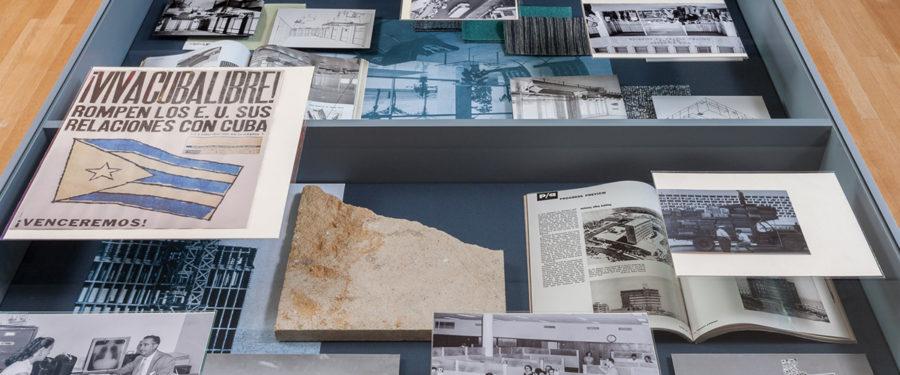As part of the second Chicago Architecture Biennial and EXPO Chicago celebrations, the Neubauer Collegium for Culture and Society presents Havana Case Study in its building on 57th Street and Woodlawn. Part research and part art installation, the project examines the architectural history of the U.S. Embassy in Havana, Cuba, and is the second in a series that explores U.S. international relations through American diplomatic architecture.
New York–based Canadian artist Terence Gower began the project, in part made possible by the prestigious Guggenheim Fellowship, almost a decade ago in 2010.
The majority of Havana Case Study consists of four vitrines that contain archival documents and photographs arranged in the style of a museum exhibition. Plastic-sleeved photographs and newspaper clippings from after the Cuban Revolution cover the vitrines to create two layers of information for the audience to peruse.
All artifacts explore the design and use of the Cuban U.S. Embassy in its multiple historical contexts, from its initial goal to create architecture that articulated U.S. foreign policy in a positive light, to its abandonment until the resumption of U.S.-Cuban relations in 2015.
Gower called the “centerpiece” of his exhibition the replica of the only balcony of the Havana Embassy. A State Department surveyor wrote in a report that this balcony was “Mussolini-style” and evocative of U.S. imperialism. A 1:1 scale rebar sculpture of the balcony is displayed on the balcony of the Neubauer Collegium itself.
Reception of the exhibition varies; a member of the public was disappointed by the artwork, saying that the sculptural and archival components of the exhibition were “disparate” and left “a lot to be desired.” On the contrary, professor Jonathan Lear described the exhibition as emblematic of the Neubauer Collegium’s “unusual but important work.”
“Art projects like [Gower’s]…are integral to the kinds of thinking and research that will assist us in explicating the problems of our time,” he said during the opening reception.
Gower noted that the exhibition is in no way “a static archive,” and that he will continue to “add to the pile of history” on the vitrines as more materials become available. The audience is encouraged to engage with the artifacts displayed and to interpret the historical documents as they see fit.
In his artist talk, Gower also added that his interest in studying local building technologies and traditions is a result of his belief in the ability of design to facilitate dialogue.
“Architecture contains…our hopes and dystopias,” he explained. “This exhibition is an exploration of that in the [context of] U.S. international relations.”
The exhibition will run until December 15. Gallery hours are Monday to Friday from 11 a.m.–5 p.m.









